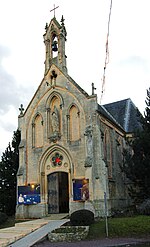Second Battle of the Odon

The Second Battle of the Odon comprised operations fought by the British Second Army during the Second World War. Attacks took place in mid-July 1944 against Panzergruppe West, as part of the Battle of Normandy. Operations Greenline and Pomegranate were intended to draw German attention away from Operation Goodwood, an attack from the Orne bridgehead on 18 July. The British wanted to prevent the Germans from withdrawing panzer divisions from opposite the Second Army to create an armoured reserve which could oppose the First US Army during the Operation Cobra offensive in the west. The operations in the Odon valley kept three German armoured divisions in the front line west of Caen, away from the Goodwood battlefield, east of the Orne.
Excerpt from the Wikipedia article Second Battle of the Odon (License: CC BY-SA 3.0, Authors, Images).Second Battle of the Odon
Impasse du Champ Picard, Caen
Geographical coordinates (GPS) Address Nearby Places Show on map
Geographical coordinates (GPS)
| Latitude | Longitude |
|---|---|
| N 49.079722222222 ° | E -0.47111111111111 ° |
Address
Impasse du Champ Picard 9
14210 Caen
Normandy, France
Open on Google Maps










